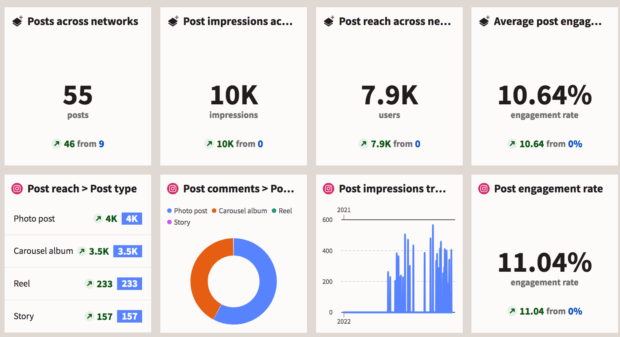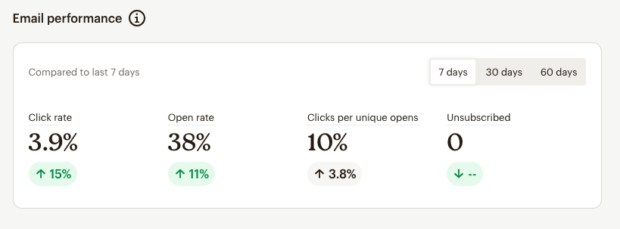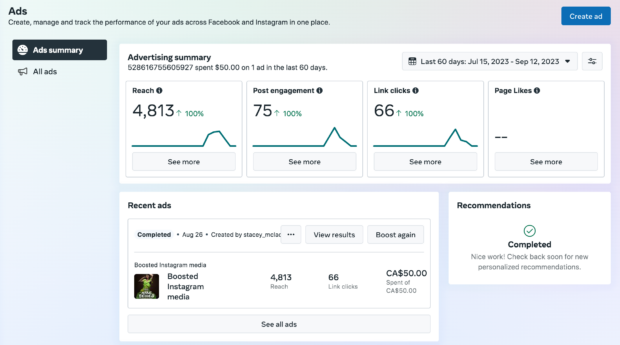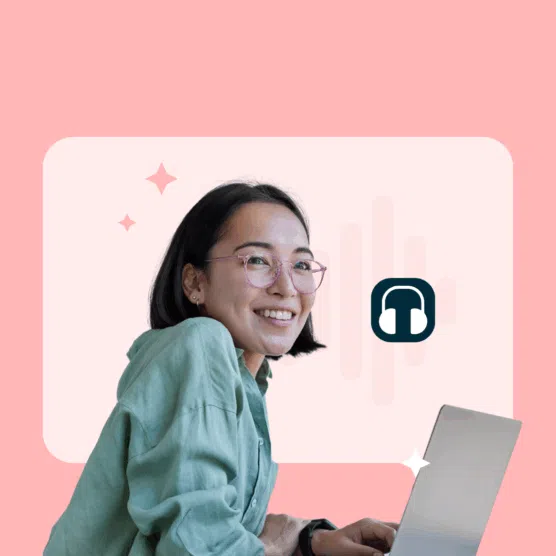Have you ever heard the phrase, “all sizzle, no steak”? It’s the perfect “meaty” metaphor for social media vanity metrics.
It can absolutely be exciting to rack up the likes or see your follower count jump. Of course you want to shout your reshare rate from the rooftops!
But be careful. any social metric can turn into a “vanity” metric if you’re bragging about it without any context.
Social media metrics are incredibly important for a social media manager and shouldn’t be ignored. They can be key performance indicators: numbers that inform and measure your social media strategy and help your team see where you’ve been and where you’re going.
But here’s the thing. Not all social stats are created equal. For a metric to be meaningful, it has to tie back to your business objectives.
Lucky for you, we’re here to help you cut through the vanity-metric hype to find those beefy, meaty metrics that help you prove the true value of your social media marketing.
What are vanity metrics?
A social media metric is a number that quantifies a particular action or behavior related to your social media account. A vanity metric is a social media metric that looks impressive at a glance but doesn’t necessarily indicate a company’s overall success in reaching its goals.
In the words of the all-mighty Hootsuite glossary:
A vanity metric is an analytics item that can be measured but is not a signifier of real return on investment. Examples include the number of followers, likes, or comments on social media posts. These metrics are best contextualized by more concrete numbers such as click-through rate or visitor-to-lead conversions.
For example, the social media manager at the Acme Alarm Clock Company might be able to show the CEO that there are 200,000 followers on the brand’s Instagram account. But the goal of the company is actually to sell alarm clocks. And sales haven’t improved at all with this growth in followers.
So, in this case, follower count is actually a vanity metric. Sure, it sounds good on paper, but ultimately, it’s not helping the CEO move those clocks.
The moral of the story: any social media statistic from any social media platform can be a vanity metric, depending on the situation.
The number of likes on a TikTok video isn’t meaningful if your target audience isn’t on TikTok.
The number of comments on your Instagram Story doesn’t mean much if they’re all from spam accounts.
A brand’s follower count can skyrocket, but if those followers aren’t engaging with your content, what good is that? (Which reminds us: never buy followers. Trust us.)

In other words, a “vanity metric” for one brand will be totally different from a vanity metric for another brand. It all ultimately depends on what business success you’re hoping to get from your social media strategy.
Beautiful reports. Clear data. Actionable insights to help you grow faster.
Vanity metrics vs. actionable metrics
Now that you’re crystal clear on what a vanity metric is, you’re probably curious about what an actionable metric might be. Don’t be embarrassed, it’s only natural.
Actionable metrics are social media metrics that are all meaningful — important social media metrics that help you measure, analyze, and strategize. Actionable social media metrics provide concrete insights and can be directly tied to specific actions that drive business growth. Really, an actionable metric is just the opposite of a vanity metric.
While much of life exists on a spectrum, for social media metrics, a number is either pure vanity or truly actionable. But what side of the binary any given social media metric sits on, of course, will depend on the social media account. We’re all beautiful flowers, et cetera, et cetera.

Vanity metrics examples
We’ve said it before, but we’ll say it again: It’s important to note that any metric can be a vanity metric without proper analysis. And any metric can be meaningful when presented in context with the proper analysis. That being said, the following metrics are most commonly prone to being viewed as vanity metrics for any given field.
Vanity metrics in social media marketing
In social media marketing, vanity metrics include follower count, likes, and comments. Sure, these numbers can offer a quick ego boost, but the truth is, they often fail to reflect the true engagement and influence of your brand on your business’s bottom line.
This might lead you to ask: so, what are the actionable metrics for social media marketing? Engagement metrics like engagement rate are probably meaningful numbers that can offer you and your team some insight. Shares also say more about whether your content is resonating with your audience than likes (try putting your posts through Rachel Karten’s shareability test).
But at the end of the day, it really depends on what your specific goals are with social media and your business.
Vanity metrics in digital marketing
Digital marketing encompasses a wide range of channels, including social media, email marketing, and advertising, so this is a pretty tough one to identify vanity metrics for. In some cases, vanity metrics for digital marketing could be likes; in another case, it could be page views.
If you’re tracking the ROI of digital marketing, you need to identify vanity metrics specific to each channel to make sure that you can prioritize actionable metrics that align with your unique business goals.
Vanity metrics in content marketing
Social media can be a great tool for driving traffic to your blog posts, articles, whitepapers, or research docs… and content marketing, in turn, can be an effective conversion or branding tool. This leads many people to assume that pageviews or click-throughs are the metric for measuring success. In reality, these can be vanity metrics.
Is your bounce rate low? Is the time spent on the page high? Those are numbers that can provide context to the pageview stats and let you know if those views are actually valuable. (Metrics like conversion rates, in this case, can be far more informative about the impact of your content on audience behavior.)
Vanity metrics in email marketing
People are opening your emails! That’s wonderful news!
But are they actually reading those emails? Are they clicking on your links?
Is anyone actually buying any of those alarm clocks you’re still trying desperately to sell? If not, your high open rate might actually not be that impressive after all. (Sorry!)

Open rates and click-through rates are commonly mistaken as the ultimate indicators of email marketing success. But the truth is that conversion rates and revenue per email are more actionable metrics that reveal the true ROI of your email campaigns.
Vanity metrics in advertising
The online advertising industry is built on the back of impressions. After all, if Meta tells you you’ve reached 300,000 people, that certainly sounds like a good use of $100. But impressions and click-through rates in advertising can be deceiving.

A more concrete way to measure the success of a social media advertising campaign would be to concentrate on metrics like cost per acquisition (CPA) and return on ad spend (ROAS). These are stats that will more accurately allow you to assess the profitability of your advertising efforts.
Vanity metrics in brand management
While they can be really important and helpful, metrics like social media reach and sentiment scores can also be misleading out of context.
Just because someone has seen your post doesn’t mean they care for your brand or products. Just because you have a positive sentiment score doesn’t mean that your target audience likes you more than your competitor. (Oof.)
To gauge brand perception accurately, consider metrics like brand awareness, customer lifetime loyalty, and Net Promoter Score (NPS). But, again, a meaningful brand management metric really will vary from brand to brand, depending on what you’re trying to accomplish with your brand management strategy.
Vanity metrics in search marketing
You’d think measuring the success of search marketing efforts would be simple: did people find you when they searched for you? But metrics like rankings and organic traffic numbers can be surprisingly superficial.
Instead, focus on metrics like organic conversion rate and keyword ROI to measure the actual impact of your SEO efforts. (Psst, while you’re here, maybe brush up on your social SEO skills?)
Vanity metrics in public relations
In the PR world, metrics like media mentions may seem like an obvious mark of success. But that number is really just a surface-level impression of the success of your efforts.
To really see the impact of public relations work, you might be better off focusing on metrics that demonstrate the impact on your brand’s reputation and credibility — think sentiment analysis and share of voice.
So there you have it: everything you ever wanted to know about vanity metrics for social media. Please, please, no need to thank us. Just go forth and practice analysis with all this info!
Go beyond vanity metrics and track the real value of your social media performance with Hootsuite. Publish your posts and analyze the results in the same easy-to-use dashboard. ROI has never been easier to prove. Try it free today.







